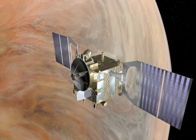Solar researchers set sights on Venus

Venus Express. Image courtesy of ESA
11 April 2006
Tuesday 11 April, 2006
Solar system researchers set sights on Venus
One of the UK's leading science research groups dedicated to studying the solar wind opens a new chapter in its distinguished history today as the European Space Agency's Venus Express mission goes into orbit.
For over half a century scientists from the Institute of Mathematical and Physical Sciences (IMAPS) at the University of Wales, Aberystwyth have made a major contribution to the study of the Sun and the effects of space weather on the Earth.
The Venus Express mission, which was launched in November 2005, will extend the groups research work to study the connections between the Sun and Mars, Venus and Mercury as well as the Earth.
Dr Andy Breen is Deputy Director of the Solar System Research Team.
“Space weather can have a dramatic effect on the Earth. Solar wind released as a result of a large eruption on the surface of the Sun can damage satellite communication systems and, in extreme conditions, cause long distance power lines to fail. The solar wind is also the cause of one of nature’s wonders, the Northern Lights which are caused when it interacts with the Earth’s protective magnetic field,” he said.
Key to the team’s work on the Venus Express mission is the Aspera 4 instrument, otherwise known as the Analyser of Space Plasmas and Energetic Atoms. This instrument will enable the Aberystwyth team to study the atmosphere on Venus, how it has developed and how it will evolve in future.
Venus is often referred to as the Earth’s sister planet because of its similarities in size, mass, density and volume. At an average distance of 108 million km from the Sun, it is about 30% closer than the Earth. However, Venus has no surface water, and has a toxic, heavy atmosphere made up almost entirely of carbon dioxide and it rains sulphuric acid. The surface of the planet is the hottest in the solar system at a searing 750 K (477 °C) which has been caused by a catastrophic greenhouse effect due to the carbon dioxide rich atmosphere.
“Venus does not have a magnetic field to protect if from the vagaries of the solar wind. As the wind hits the planet’s atmosphere it is gradually being stripped away. The big question is how, without the protection of a magnetic field, has it developed such a dense atmosphere and keeping it. Such phenomena will tell us a lot about how the Earth behaves as the underlying principles of physics will be the same,” added Dr Breen.
“One particularly exciting aspect of this work is the opportunity if affords undergraduate students to learn from an active space mission. We offer two degree programmes Space Science and Robotics, and the Physics with Planetary and Space Physics here at Aberystwyth and students here will benefit directly from the information generated by the Venus Express mission and to work on some of the data from the mission. The link between research and teaching is essential here at UWA.”
The work on the Aspera 4 instrument if being led by Professor Manuel Grande who has just joined the Institute of Mathematical and Physical Sciences as Director of the Solar System Research Teams. Professor Grande joints the Institute from the Rutherford Appleton Laboratory where he was Leader of the Planets and Space Plasmas group. He is also a Visiting Research Professor at the Planetary and Space Sciences Research Institute of the Open University and an honorary professor at Warwick University.



